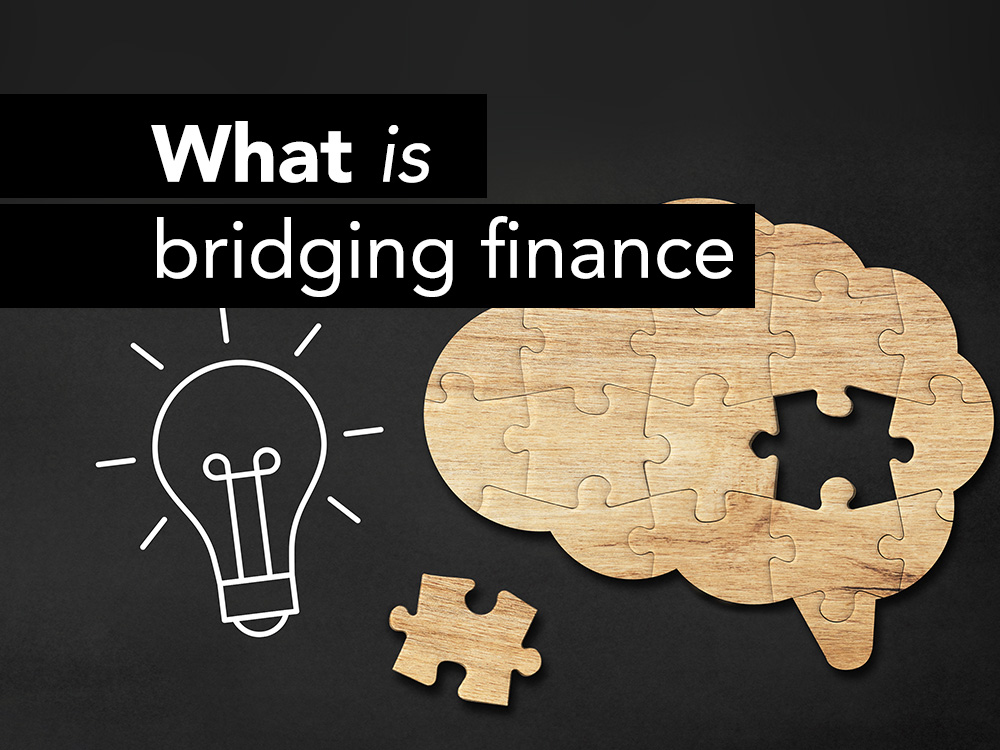What is bridging finance?
Put simply, bridging finance is a short-term mortgage – a loan secured against an asset (typically a property) which is repaid with fees and interest.

Mortgage vs bridging
There are several differences between mortgages and bridging finance, however.
Most bridging finance deals are for 12-24 months or less, compared with up to 25 years, or even more, for a mortgage.
Interest rates for bridging finance are higher than for mortgages. Instead of 5 per cent or less for a mortgage, you can expect to pay anything between 8 per cent and 24 per cent for bridging finance.
Whereas mortgage lenders will take a close look at your income, your outgoings and your personal circumstances, bridging finance companies are generally only interested in the value of the asset that you’re borrowing against.
They aren’t concerned about the condition of the property, about whether it can be rented out for example. Many properties that are used to secure bridging finance will be vacant in any case, because the money is used to refurbish them. All the bridging finance company needs to know is what the property will sell for, in case they need to do this to recoup their investment.
What’s the exit?
The main thing that bridging finance companies want to know is: what is the ‘exit’ – i.e. how will they be repaid? In almost all cases, this will be either through the sale of a property or the longer-term refinancing of the property, but it could be the sale of a business, an inheritance, the maturity of an investment or some other sum of money that will become available to a lender in due course.
Importantly, bridging finance is typically much quicker to arrange than a mortgage. Rather than taking weeks to set up a mortgage, with lenders requiring evidence of income and future prospects, bridging finance companies simply need a property valuation and can make a decision within a few days.
These loans are known as ‘bridging’ finance because they bridge the gap between buying a new property and selling an existing one: you then have the chance to act quickly and secure a new property, even when you don’t have enough money to pay for it.
In other cases they bridge the gap between paying for refurbishments to a property and selling it, thereby making enough money to repay the bridging loan.
Legal terms
In legal terms, bridging finance companies take a ‘charge’ over a property used to secure a loan. This charge is placed on the Land Registry, which means that you’re no longer able to sell the property, or raise any funds against it, without the approval of the bridging finance company.
It also means that, if you don’t repay the amount you’ve borrowed, they can sell the property to get their money back.
Expert valuation
In the same way that mortgage lenders will value your property, bridging finance companies typically also appoint a qualified RICS® certified surveyor to visit the property and draw up an expert valuation. There are some instances and lenders who, depending on the loan-to-value ratio of the finance you’re seeking and the type of property you’re offering as security, will offer you what’s known as a desktop valuation. Desktop valuations are quicker valuations obtained from 3rd party services that provide instant online valuations for property.
You may already have an idea of what you think the property is worth, but beware: surveyors are notoriously conservative and are likely to come up with a lower valuation. They know that if they put too high a figure on the property, they could end up in trouble with the bridging finance company. So they play it safe.
However, if you already have a recent valuation, you may be able to use this as evidence of a ballpark figure, which may help the surveyor to reach a decision. That being said, be mindful that bridging companies tend to trust only their specific panels of valuers where the loan-to-value ratio is high.
Bridging finance can typically cover up to 75 per cent of the value of a property, depending on its type and location. In today’s market, it’s unlikely that a lender will offer more than 80 per cent. Those lenders offering 100 per cent bridging finance on a property will require one or more additional properties as security, using the additional equity available in those properties to get the borrower where they want to be in terms of loan amount.
Apart from residential property, bridging finance can also be taken out on commercial properties, development projects and land. If land already has planning permission, bridging finance companies will lend a higher percentage of its value than if there is no permission.
A brief history of bridging finance
Bridging finance first emerged in the UK in the 1960s as a product offered by the High Street banks and building societies, to assist home buyers who needed funding when they bought a new property before selling their existing one. It was a niche product, generally available only to valued customers of the bank or building society.
Over the next 60 years, a succession of events and government interventions combined to promote bridging and provide the ideal environment for it to thrive.
1980s - The creation of Assured Shorthold Tenancies in the 1988 Housing Act sparked the buy-to-let market and with it, demand for short-term finance so that investors could buy properties, refurbish them and let them out, or buy investment properties at auction. Bridging finance was an ideal solution for this.
2000s - Self-certification (where lenders allowed borrowers to estimate their earnings and property values) meant that mortgage lending in general rose sharply, together with residential property prices. Where borrowers found themselves over-leveraged, some turned to bridging finance during the process of selling their properties.
The Credit Crunch of 2008 gave a dramatic boost to the bridging sector. After the failure of companies including Northern Rock and RBS, traditional lenders toughened their lending criteria and became far more cautious. In response, bridging finance companies took up the slack and provided much-needed liquidity to the market, enabling transactions to proceed which were threatened by bankers’ reluctance to lend. It also meant that properties that had fallen into disrepair could be renovated and made habitable.
2010s - In 2014, the UK government introduced tougher mortgage lending rules, phasing out self-certification, to prevent irresponsible lending. This further curtailed the traditional lenders yet offered another boost to bridging finance providers.
Later changes restricted lending to the buy-to-let market. Once again, the sector benefited as investors, builders and developers looked to bridging finance for support.
As the Association of Short-Term Lenders puts it, bridging finance offers a fast and common-sense approach to lending requirements, with ‘the knowledge that each case will be treated on an individual basis and not be subject to rigid and often unattainable lending criteria.’





